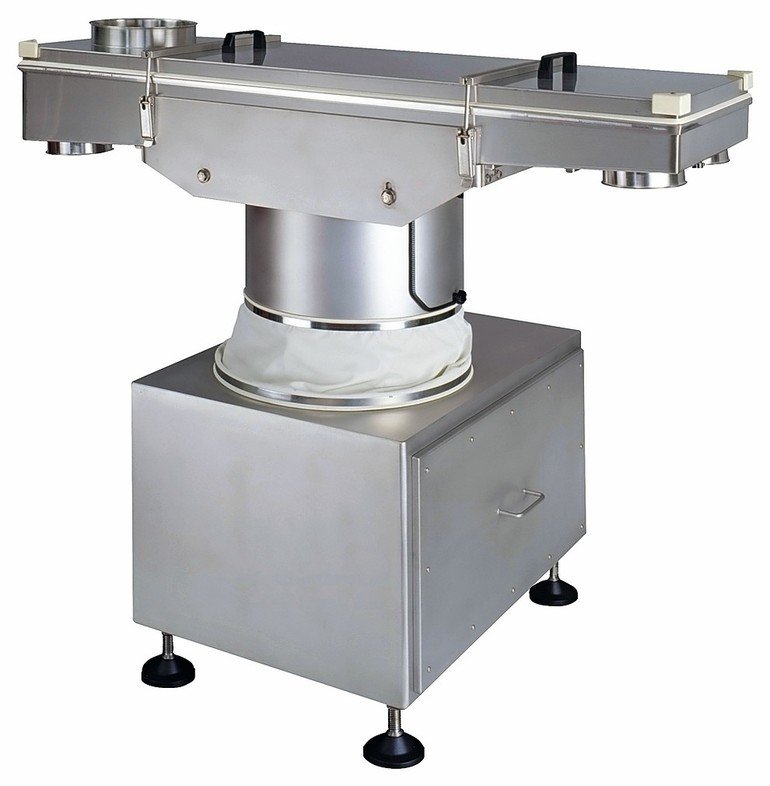Sifting plastic granules and especially masterbatches aims to separate granules that are too big (so-called longs) and grains that are too fine from the good product. The sifting process tends to increase the quality of the granules to enable them to be sold more easily or at a better price. Nevertheless, sifting is not exactly a simple process and a thorough analysis of the problem was required, as well as a large number of trials, before the theory could be converted into practice and the desired result achieved.
Optimal control sifting of plastic granules
Jumping not allowed
Sifting plastic granules and especially masterbatches aims to separate granules that are too big (so-called longs) and grains that are too fine from the good product. The sifting process tends to increase the quality of the granules to enable them to be sold more easily or at a better price. Nevertheless, sifting is not exactly a simple process and a thorough analysis of the problem was required, as well as a large number of trials, before the theory could be converted into practice and the desired result achieved.
The problem with sifting lies in the fact that plastic granules do not behave in the same manner as many other materials. In fact, most sifting machines do not operate in a satisfactory way when used for plastic granules. Granules which are too long and need to be removed tend to remain in the final product, either because the sifting surface is too large or because the selected sifting technique is inadequate. Often, both reasons apply.
In most situations, the bigger the sifting surface, the higher the quality or the throughput of the sifted material. However this will not be the case when plastic granules which are too long are removed. As the size of the sifting surface increases, so does the probability of a long granule falling vertically through a hole in the sieve. In addition to this, inappropriate sifting techniques (for instance, a vibrating sieve) cause more and more of these granules to jump into a vertical position and fall through a hole. It was while trying to understand the problem more explicity that Fuchs Machines hit upon an interesting discovery:
- If possible, the thickness of the product layer should be constant over the whole of the sieve surface (in this case a perforated plate) at the start of sifting and in the order of 2 to 5 cm. It is then possible to avoid long granules moving into a vertical position and falling through a hole.
- The thickness of the layer should ideally remain constant throughout the sifting process. If this cannot be guaranteed some of the granules will show a tendency to jump over the remaining surface in an uncontrolled manner, increasing the likelihood of vertically positioned granules falling through a hole in the sieve. The sifting surface should therefore not be too large and adapted to the sieve throughput.
- The sieve movement should not contain vertical components, since these will only exacerbate the jumping effect.
- The frequency of the sieve movement should be as low as possible. The best sifting results are demonstrably obtained with low-speed sieve movements while the jumping effect of the granules worsens at higher frequencies.
- Taking these findings into account, it is clear that the Fuchs Siftomat plansifter offers very good conditions for sifting plastic granules, as the sifting movement has no vertical component. Additionally, the rectangular shape of the sifter has the advantage that in contrast to circular units, the sifting width does not increase during the process. Fuchs also divides the sifting surface – the perforated plate – into several perforated and non-perforated segments. It is thus possible to adjust the perforated plate surface to the required capacity by inserting only as many perforated segments as necessary. The remaining segments are not perforated and sieve surfaces which are too large are avoided.
The solution
The frequency of the plane circular sifter movement is as low as possible, without interfering with the conveying of the material to be sifted. The process can be adapted to specific requirements and optimised using a frequency converter. The slope of the sieve can also be altered. A steeper slope is recommended for high throughputs requiring rapid transport of the material to be sieved.
Both the sieve case and the sieves themselves have a modular design. The sieves and the spacer frames can be removed and replaced very easily in order to clean the sieve case and change the sieves, for instance when other plastic granules must be processed.
Hall 2, booth 217
www.cpp-net.com search: cpp0116fuchs
Share:







